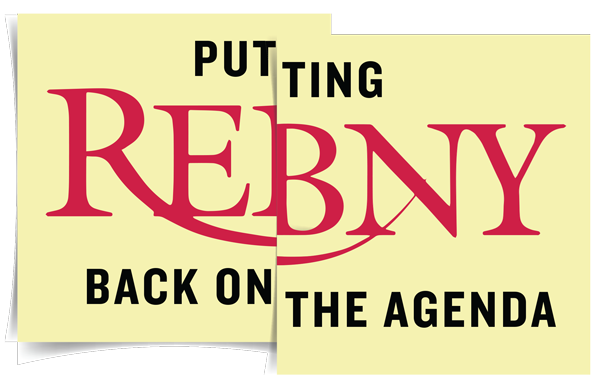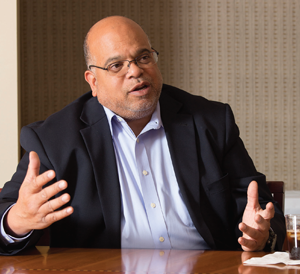Trending
Putting REBNY back on the agenda
Lobbying group scores a trifecta on residential listings, Midtown East and affordable housing, but can it replicate its recent wins?

If only the Real Estate Board of New York got commissions for closing deals. Within a span of four months, at a pace that would make even top dealmakers envious, the influential trade association checked off three items that had loomed large on its agenda for years.
Most recently — after five years of wrangling that spanned two administrations at both REBNY and City Hall — the City Council voted unanimously on Aug. 9 to rezone a 78-block swath of Midtown East. The deal paves the way for 6.5 million square feet of new office space and tens of millions of dollars in mass transit upgrades, as well as new public plazas and atriums.
That breakthrough came just eight days after REBNY launched its long-awaited Residential Listing Service, giving brokers a heftier arsenal in their escalating war with the online listings giant StreetEasy. And it’s been less than five months since the 421a tax abatement was brought back to life as Affordable New York with the board exerting its influence throughout the legislative process.
“It’s certainly been a busy year,” deadpanned REBNY’s John Banks, who picked up the baton on all three initiatives in the spring of 2015 when he succeeded longtime president Steven Spinola.
Related: A who’s who of top REBNY brass
Still, for every win that REBNY brought home, there were other demands it left on the negotiating table — from missed opportunities for developers on 421a and Midtown East to a weaker position with StreetEasy than many in the residential world would have liked.
But after a rocky stretch marked by sharp divisions among the board’s more than 17,000 members, Banks and his staff of 49 have ironed out the kinks while raising the bar for what’s to come.
“That they were able to accomplish so much with new leadership in the executive office is a testament to the organization,” said Kathryn Wylde, head of the Partnership for New York City, which represents many of the city’s largest businesses. “These aren’t short-term efforts.”
The Real Deal went behind the scenes at REBNY’s headquarters at 570 Lexington Avenue to see how the sudden flurry of advances is playing with the board’s members and find out what the power brokers plan to do next.
Resi revolution
REBNY has long been accused of neglecting New York’s residential brokers in favor of the industry’s more expansive commercial side.
But that perception is quickly changing.
For the first time in the five boroughs, every residential listing can be found in one place, courtesy of REBNY’s syndication service, which launched on Aug. 1. Whether or not it lives up to expectations, the RLS sends a powerful signal to members.
“I think it’s a huge victory for the residential sector,” said Town Residential CEO Andrew Heiberger, who went on to hail the new system as “the single biggest victory” in his quarter century as a REBNY member.
The syndication platform takes a welter of listings submitted by hundreds of brokerages and consolidates them into clean data pools that get sent to popular consumer websites such as Realtor.com and Homes.com.
Over time, the board hopes that eliminating the hassle of having to cobble together listings from multiple sources will make it easier for new companies to break into the market and develop products that help get the listings in front of consumers.
“Simply put, we’re eliminating the No. 1 barrier to entry for new products,” said RLS deputy director Stefan Martinovic, one of five new hires REBNY made in the last 12 months to build out the system.
NYC’s residential players embraced the news as they battled with StreetEasy over its decision this year to launch Premier Agent, which allows sales brokers to pay for better placement on the site. StreetEasy also began charging agents to post their rental listings, which sparked even more fury.
Long a broker pipe dream, REBNY’s syndication service got a major lift last November — several months before the StreetEasy drama unfolded. The board of directors for the organization’s residential brokerage division voted unanimously to raise the dues REBNY levies on more than 13,000 brokers to drum up $1 million for the RLS push.
Under director Freddy Sarabia, the team devoted months to cleaning up duplicate and faulty listings and readying the system to go live. Meanwhile, REBNY took out ads in the New York Post in August promoting a citywide series of open houses on Thursdays.
Like many others, Donna Olshan, president of her eponymous brokerage, hailed the syndication effort as “long overdue.” But she lamented that REBNY didn’t go far enough toward setting up its own consumer-facing site that would give brokers ultimate control over their listings.
REBNY insists that the infant system is still very much a work in progress.
“Our priority right now is to give consumers the ability to access the most accurate and consistent listing information provided by the RLS through hundreds of websites,” said Martinovic, noting that REBNY has not ruled out a consumer-facing site down the road.
Commercial win
REBNY, according to its most recently available tax filings, brought in $13.6 million in revenue in 2015, with $9.4 million of that coming from membership dues. That’s up from $10.9 million, with $7.4 million in membership dues, in 2012. Principal brokers and heads of residential firms now pay annual dues of $1,650, compared to the $1,100 that top commercial agents and principals pay.

John Banks
And while more than 75 percent of REBNY’s members are on the residential side, New York’s commercial real estate players have long had greater influence among the board’s top brass. So when it came time to pick up the pieces of the Midtown East rezoning push that had unraveled in the closing days of the Bloomberg administration, REBNY left no stone unturned.
Under longtime research director Michael Slattery, the board’s eight-person data team launched an information warfare campaign starting in late 2015. All told, REBNY’s researchers pumped out half a dozen reports totaling nearly 100 pages and buttressing the industry’s case on everything from density to the price of air rights.
“There were clear and outright misstatements of facts in public hearings, but they catch on and people keep repeating them,” Slattery said. “We would respond and say, ‘No, that’s not the only side of the story.’”
A key battle centered on where to set the floor price for sales of buildings’ unused development rights — 20 percent of which the city would use to fund upgrades in the “public realm.” For Dan Garodnick, who represents much of Midtown East in the City Council and whose thumbs-up on the deal was all but mandatory, those civic improvements became a vital component.
Initially, the Department of City Planning proposed a floor price of $393 per square foot for such rights. Slattery and his team accused the city of faulty methodology and countered with a sum less than half that — $179 per square foot, a level that certainly would be more attractive to potential buyers in the development community.
REBNY’s calculations won the backing of Manhattan Borough President Gale Brewer and others. But in the end all parties compromised on roughly $307 per square foot, with about $61 going to infrastructure projects.
Garodnick said his prime objectives were to ensure “an opportunity for as-of-right development and a rock-solid commitment for public improvements,” emphasizing that he was unwilling to compromise on the latter.
“I stopped the prior version of this plan because it delivered a whole lot of certainty to the real estate world with few guarantees that the public would see tangible benefits as a result of new density,” he told TRD. “For a plan to truly improve the district’s future, we needed certainty all around.”
That made REBNY’s task even greater.
“In our opinion, REBNY did as good a job as it could do, considering that Dan Garodnick needed to have some type of substantial payment for public improvements,” said Ron Novita, an air rights expert at the brokerage City Center Real Estate, who corresponded with Slattery and his team multiple times during the Midtown East affair.
Even on relatively small points, REBNY rolled out its biggest data guns. That included a 12-page study on why new high-rise development would have little impact on the hours of sunlight that fall on Greenacre Park, the 6,360-square-foot “urban oasis” with a waterfall on East 51st Street.
With help from REBNY members well versed in urban design, Slattery and his team succeeded in showing that most of the sunlight reaching the park came from the east and therefore wouldn’t be affected by potential development on the west.
Banks conceded that REBNY didn’t get everything it wanted on the Midtown East rezoning (the board failed to expand sites on midblock properties and was unable to push the rezoning to the east side of Third Avenue). But he insisted that what the board did get will lead to significant improvements for an area that boasts a working population of 250,000 and contributes roughly $1 out of every $10 in property taxes collected annually in the city.
“Are we happy with everything? No, of course not,” Banks said. “But it’s a positive opportunity for the East Midtown corridor to grow and advance.”
Tax break’s return
Less than a year after former REBNY Chair Mary Anne Tighe told TRD that the board’s efforts to replace 421a have been the “hardest of all,” Gov. Andrew Cuomo signed a replacement into law in April.
The Affordable New York tax abatement for developers of below-market rental housing promises annual subsidies estimated at $2.4 billion. Banks called the measure a good start and one that “certainly has enough to incentivize our membership to go out and build as much affordable housing as they possibly can.”
The breakthrough came after a series of on-again, off-again negotiations had failed to produce results. Finally, REBNY and the Building and Construction Trades Council of Greater New York — the umbrella organization for the city’s union hard hats — reached a framework agreement on issues such as wages and the length and value of the tax abatement in November 2016.
Leaving nothing to chance, Banks began working out of the Albany offices of law firm Greenberg Traurig in April. It was there that he put in long hours with REBNY’s Jim Whelan, who runs its political action arm, and Michelle Adams, who heads community and government relations for Tishman Speyer, REBNY Chair Rob Speyer’s family real estate firm.
“What we were negotiating was between the Senate, the Assembly and the governor’s office — dotting the i’s and crossing the t’s,” Banks said. “You want to get the language as tight as you can.”
The work dragged on through the month as rumors bounced between an imminent deal and its sudden collapse.
In the end, one of REBNY’s biggest successes is not some key point that it got written into law, but rather something it made sure got left out. Democrats in the state Assembly had mounted a strong push to tie approval for a new tax abatement to rules that would make it harder for New York landlords to turn rent-regulated apartments into free-market units.
Republicans and the Independent Democratic Conference in the state Senate — two groups that receive large sums of campaign cash from REBNY and its members — made sure the two issues will stay independent.
“What REBNY prevented from going into the agreement was just as big as what it actually put in,” Wylde said.
But there’s still much to be done, including figuring out how 421a will work with other affordable housing programs. In June, the city’s Department of Housing Preservation and Development introduced a proposed rule change that would bar developers who receive the tax break’s benefits from selling air rights generated through the city’s mandatory inclusionary housing program to other development sites.
And Heidi Burkhart, president of the affordable housing brokerage Dane Real Estate, warned that the higher construction wages negotiated by REBNY and the Building Trades Council could stifle development on projects with high land costs and thin margins. But she acknowledged that the negotiation process was about give and take.
“The best negotiations are when everyone feels they left something at the table,” she said.
On the horizon
While REBNY has scored high on three major fronts this year, at the end of the day that simply clears time and space for the lobbying group to take on its next series of challenges.
Among those are a package of no less than 21 construction safety bills the City Council put on the table for discussion in January.
The proposals address everything from regulating how and when cranes can be operated to more thoroughly documenting construction worker fatalities. Most controversial, as REBNY sees it, is a proposal to mandate extensive new safety training. Critics in the real estate industry lambast the measure as a backdoor way for organized labor to preserve its shrinking slice of the construction market, since unions have the infrastructure in place to provide the training.
Banks, however, said the new rules would do little to foster safety, noting that most accidents happen on small job sites that wouldn’t be required to employ workers who went through the training program. And the proposed 59 hours of training, REBNY argues, could prove burdensome for nonunion workers who can’t afford to forgo a day’s pay to sit in a classroom.
Meanwhile, one of the great perennial issues for the sector, property tax reform, has resurfaced. In January, REBNY put out a policy paper showing that the industry paid $20.4 billion in NYC taxes in 2016, or 43 percent of the total, up 2 percentage points from 2013.
In April, REBNY’s salvo was followed by one from an unusual assemblage of tax reform advocates called Tax Equity Now. The group’s members — ranging from the NAACP to developer heavyweights including the Durst Organization, RXR Realty and Related Companies — filed a lawsuit in state Supreme Court claiming NYC’s property tax system is racially biased and tipped in favor of affluent homeowners at the expense of working- and middle-class residents.
In a city where property taxes are notoriously low for those who own single-family houses, condos and co-ops, a far heavier tax burden falls on rental buildings, where most New Yorkers live. That, critics say, further drives up rents.
In July, Mayor Bill de Blasio announced plans to make property tax reform a priority if he’s re-elected. Banks said that he hasn’t had a meeting with the mayor to talk specifically about what de Blasio has in mind, but acknowledged the mounting attention the issue is garnering.
“The problem is that over time, the inequities get worse and worse and worse,” he said. “And I think there’s a growing recognition that we are at a stage where we need to commit some time and energy to focusing on it.”
REBNY’s stand on the issue has yet to be determined, but in the near term the board will focus on city elections. Ten open seats on the City Council will be up for grabs come November, and new leadership, including a council speaker and a chair of the powerful Land Use Committee, will take over.
Banks said REBNY is mulling its options in the various races.
“I don’t want to give away what I’m going to spend or what I’m going to do,” he said. “Stay tuned.”




